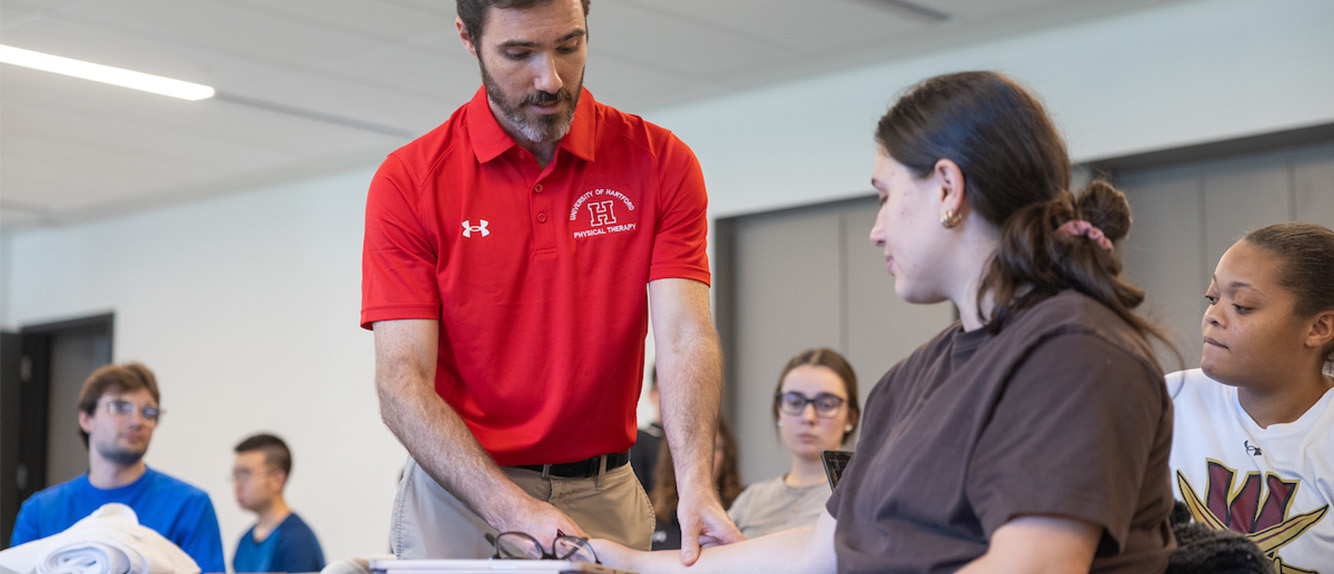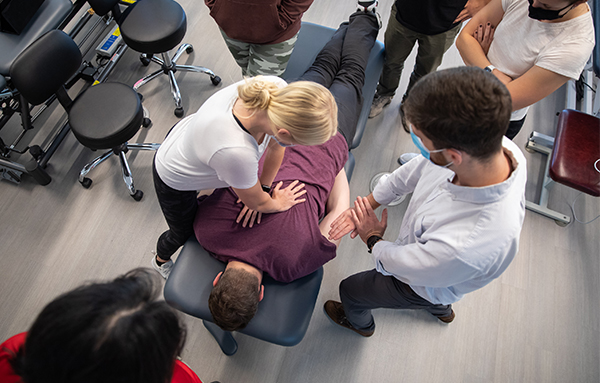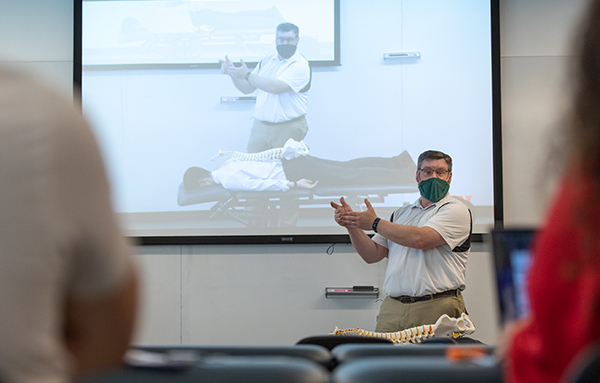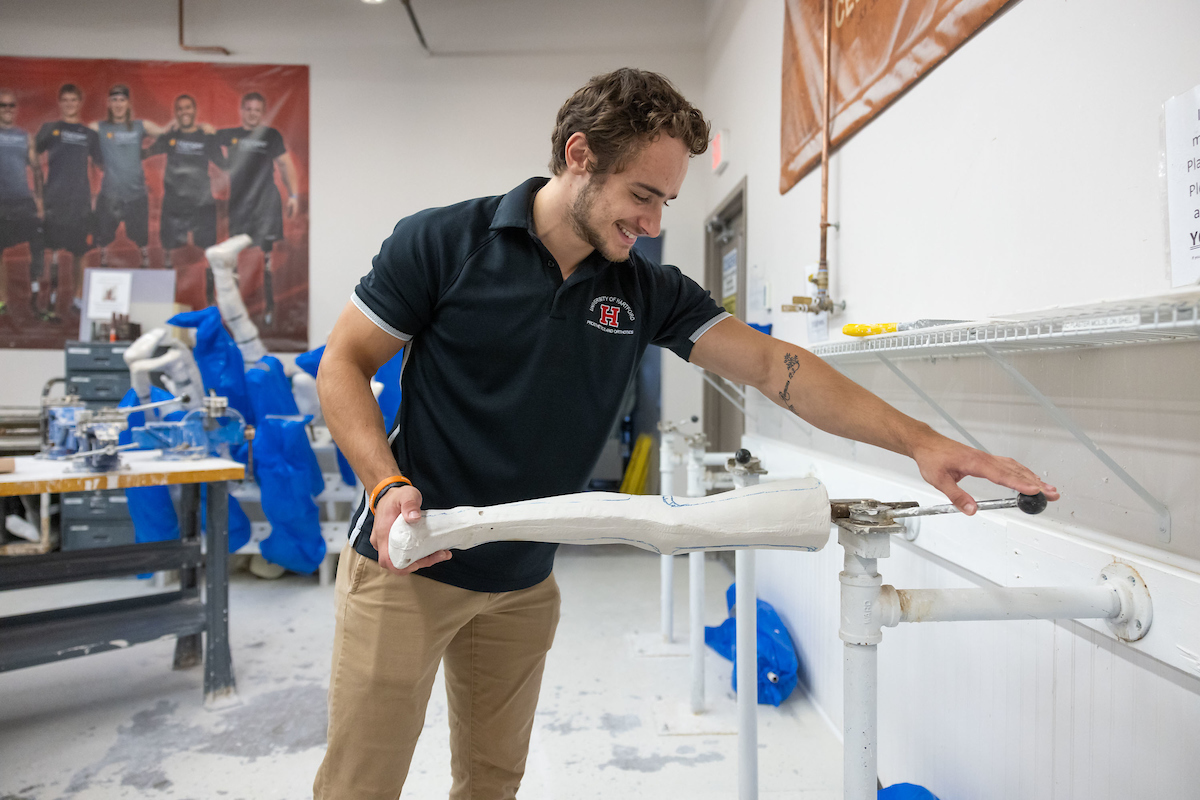
Physical Therapy - DPT
The DPT is an entry-level professional physical therapy program designed for individuals with a bachelor’s degree in another subject area who have satisfied the prerequisite course requirements.
The 12-credit certificate for licensed, practicing therapists provides clinicians with an advanced, clinically relevant orthopedic curriculum emphasizing PT diagnostic skills, manual therapy, exercise, and clinical reasoning.
Certificate
12 Credits
The 12-credit Certificate in Advanced Orthopedic Physical Therapy provides clinicians with an advanced, clinically relevant orthopedic curriculum emphasizing PT diagnostic skills, manual therapy, exercise, and clinical reasoning. The online and weekend course format allows licensed, practicing therapists to continue their regular employment while enrolled in the program. Students who successfully complete the certificate program are eligible to test for an additional credential as a Certified Orthopaedic Manual Therapist (COMT).

The Certificate in Advanced Orthopedic Physical Therapy is designed for the clinician who wants to improve their clinical practice but may not be able to commit to a full-time residency program. You can complete this 12-credit program in as little as 12 months - or complete it at your own pace (up to 36 months).

What makes the University of Hartford certificate program different from other continuing education offerings?
Built on a solid, evidence-based foundation, all content within the program is taught by true experts in the field. These instructors are not just academics and researchers, but also clinicians with extensive real-world clinical experience.
We offer more than just a few new “toys” or “tools for your toolbox.” As a clinician who wants to provide the best care for your patients, there are not many experiences that are more frustrating than taking a continuing education course and leaving with a handful of techniques, but without the context to apply them successfully. We teach effective, biomechanically and physiologically sound techniques and the clinical reasoning skills to use them successfully.
Content and concepts are based on the principles of EBP, but we do not stop there. We recognize the limitations to practice based on the results of randomized clinical trials or systematic reviews that may not always translate to the patient in front of you at any given moment (n=1). We consider examination findings from a probabilistic approach, since we realize that “clinical prediction rules” aren’t really “rules” at all… they serve to shift the likelihood of success, not guarantee it. We consider treatment determinations utilizing a mechanism-based approach and the interpretation of individually modifiable factors…real-world skills that you can apply in the clinic immediately.
The program offers multiple options for practicing therapists to enhance their knowledge and skills.
Option 1: Certificate in Advanced Orthopaedic Physical Therapy
Option 2: Individual CEU Courses
Option 3: Certified Orthopaedic Manual Therapist (COMT)
Prerequisites: Must hold a valid state license to practice physical therapy, successful completion of the Certificate in Advanced Orthopaedic Physical Therapy.
This Certificate in Advanced Orthopaedic Physical Therapy serves as the backbone of the COMT curriculum. The program has a rolling start and you may begin with any of the 12 onsite courses. All courses must be completed with a grade of 80% or better. Upon successful completion of the required coursework, you are qualified to sit for the COMT examination, currently offered in July each year.
The COMT will consist of three distinct components, which will all occur over the course of a single testing day:
Emphasis of this exam will include the basic principles of OMT, clinical reasoning and decision-making, practitioner safety, and overall skill application.
All individuals who successfully complete the examination will be qualified to assume the professional designation of “Certified Orthopaedic Manual Therapist” (COMT).
Please note that the COMT exam fee is currently $750.00.
The full Certificate in Advanced Orthopedic Physical Therapy consists of 12 one-credit courses. See the section below for course descriptions.
| Summer 1 | Credits | 2025 Dates | On-Campus Dates | |
|---|---|---|---|---|
| PT 900 | Foundations of Exam/Mechanisms of Manual Therapy, Exercise, and Pain Neuroscience (Online Only) | 1* | 7/14-8/15 | NA |
| PT 901 | Advanced Medical Screening for Orthopaedic Therapists | 1 | 7/14-8/15 | 8/10 |
| Subtotal | 2 | |||
| Fall | Credits | 2025 dates | On-Campus Dates | |
| PT 902 | Advanced Clinical Practice for the Lumbar/SIJ Region | 1 | 8/26–9/22 | 9/20-9/21 |
| PT 903 | Advanced Clinical Practice for the Thoracic Spine | 1 | 9/23-10/20 | 10/18-10/19 |
| PT 904 | Advanced Clinical Practice for the Cervical Spine | 1 | 10/21-11/17 | 11/15-11/16 |
| PT 905 | Advanced Clinical Practice for TMD | 1 | 11/18-12/16 | 12/6-12/7 |
| Subtotal | 4 | |||
| Spring | Credits | 2025 dates | On-Campus Dates | |
| PT 906 | Advanced Clinical Practice for the Hip | 1 | 1/22–2/12 | 2/8–2/9 |
| PT 907 | Advanced Clinical Practice for the Knee | 1 | 2/13–3/12 | 3/8–3/9 |
| PT 908 | Advanced Clinical Practice for the Foot/Ankle | 1 | 3/13–4/10 | 4/5–4/6 |
| PT 909 | Advanced Clinical Practice for the Shoulder | 1 | 4/11–5/9 | 5/3–5/4 |
| Subtotal | 4 | |||
| Summer 2 | Credits | 2025 dates | On-Campus Dates | |
| PT 910 | Advanced Clinical Practice for the Elbow/Wrist/Hand | 1 | 5/19-6/16 | 6/14-6/15 |
| PT 911 | Advanced Clinical Practice: Vestibular Rehabilitation for the Orthopaedic Therapist | 1 | 5/26-6/23 | 6/21-6/22 |
| Subtotal | 2 | |||
| Total Credits | 12 | |||
This course covers four distinct areas of orthopedic physical therapy, each with a unique role within the clinical reasoning process. Beginning with the principles of the orthopedic physical examination, subjective, objective, and selective tissue examination principles are covered as necessary for generating a provisional differential diagnosis of dysfunction. The clinical reasoning of the initial examination is reviewed and discussed as a guide to treatment decision making. The science of tissue healing is reviewed for tissues including muscle, ligament, tendon, cartilage, and nerve including the implications for manual therapy and exercise. Current theories on the mechanisms of manual therapy are reviewed as a foundation for clinical decision making. Finally, the principles of pain neuroscience and pain neuroscience education are introduced as part of a blended biopsychosocial model of orthopedic physical therapy practice. This four part course serves as the foundational background for the body-region specific courses throughout the remainder of the certificate program.
Instructors:
Brian T. Swanson, PT, DSc, OCS, FAAOMPT
Andrew Piraino, PT, DPT, OCS, CSCS, PES
Seth Hagymasi, PT, DPT, OCS, FAAOMPT
The decision to “treat,” “treat and refer,” or “refer to other healthcare providers” is a complicated and nuanced process, and often a source of uncertainty for the practicing physical therapist. This course is designed to increase the practicing therapist’s knowledge and clinical skills for screening patients for medical conditions, allowing the practicing therapist to more confidently establish the appropriateness of treatment and/or the need for referral. Differential diagnosis is addressed through comparison of systematic signs and symptoms, screening for serious musculoskeletal and non-musculoskeletal pathologies. Specific emphasis is placed on conditions that may mimic common orthopedic pathologies.
Instructor:
This course will provide the participant current evidence-based examination, advanced intervention skills, and enhanced clinical reasoning for the treatment of patients with lumbo-pelvic dysfunction. An integrated approach utilizing the concepts of Cyriax, Maitland, McKenzie, Kaltenborn, Evjenth, and others, in combination with current evidence based practice as described in the literature, will be utilized to form the foundation of an effective treatment approach. This course will provide the tools necessary to perform a complete evaluation of the entire cervical spine, diagnose the site/source of dysfunction, and apply specific, targeted interventions safely and effectively. Treatment techniques covered will include joint mobilization, traction, stabilization exercises, thrust manipulation, and patient education/management strategies. The course format includes lecture, extensive lab and demonstration time. Case study will be used to consider examination techniques, manual therapy and exercise while approaching EBP in a patient specific context.
Pre-course materials include a review of anatomy and biomechanics related to OMPT practice and differential diagnosis.
Instructors:
Brian T. Swanson, PT, DSc, OCS, FAAOMPT
TJ Bellama, PT, DPT, OCS
This course will provide the participant current evidence-based examination, advanced intervention skills, and enhanced clinical reasoning for the treatment of patients with dysfunctions of the thoracic spine and ribcage. An integrated approach utilizing the concepts of Cyriax, Maitland, McKenzie, Kaltenborn, Evjenth, and others, in combination with current evidence based practice as described in the literature, will be utilized to form the foundation of an effective treatment approach. This course will provide the tools necessary to perform a complete evaluation of the entire cervical spine, diagnose the site/source of dysfunction, and apply specific, targeted interventions safely and effectively. Treatment techniques covered will include joint mobilization, traction, stabilization exercises, thrust manipulation, and patient education/management strategies. The course format includes lecture, extensive lab and demonstration time. Case study will be used to consider examination techniques, manual therapy and exercise while approaching EBP in a patient specific context.
Pre-course materials include a review of anatomy and biomechanics related to OMPT practice and differential diagnosis.
Instructors:
Brian T. Swanson, PT, DSc, OCS, FAAOMPT
Rafael B. Ozdemirer, PT, DPT, FAAOMPT
This course will provide the participant current evidence-based examination, advanced intervention skills, and enhanced clinical reasoning for the treatment of patients with cervical spine dysfunction. An integrated approach utilizing the concepts of Cyriax, Maitland, McKenzie, Kaltenborn, Evjenth, and others, in combination with current evidence based practice as described in the literature, will be utilized to form the foundation of an effective treatment approach. This course will provide the tools necessary to perform a complete evaluation of the entire cervical spine, diagnose the site/source of dysfunction, and apply specific, targeted interventions safely and effectively. Treatment techniques covered will include joint mobilization, traction, stabilization exercises, thrust manipulation, and patient education/management strategies. The course format includes lecture, extensive lab and demonstration time. Case study will be used to consider examination techniques, manual therapy and exercise while approaching EBP in a patient specific context.
Pre-course materials include a review of anatomy and biomechanics related to OMPT practice and differential diagnosis.
Instructors:
Brian T. Swanson, PT, DSc, OCS, FAAOMPT
TJ Bellama, PT, DPT, OCS
This course will provide the participant current evidence-based examination, advanced intervention skills, and enhanced clinical reasoning for the treatment of patients with temporomandibular disorders. Background information will be reviewed with respect to common clinical presentations, including epidemiology, anatomy, joint mechanics, pathoanatomy, and pain science. Next, an effective and efficient approach to both the evaluation and management of TMD will be presented. Treatment techniques covered will include manual therapies, exercise interventions, and patient education/management strategies. The course format includes lecture, extensive lab and demonstration time. Case study will be used to consider examination techniques, manual therapy and exercise while approaching EBP in a patient specific context.
Pre-course materials include a review of anatomy and biomechanics related to OMPT practice and differential diagnosis.
Instructor:
This course will provide the participant current evidence-based examination, advanced intervention skills, and enhanced clinical reasoning for the treatment of patients with dysfunctions of the hip. An integrated approach utilizing selective tissue tension, joint mobility testing, biomechanics, and functional evaluation will be presented to form the foundation of the treatment model. An overview of current practice evidence and relevant practice applications will be provided. Conservative management and post-operative considerations will be discussed, leading to appropriate rehabilitation strategies for diagnoses such as osteoarthritis, femoral acetabular impingement, adhesive capsulitis, instability, and trochanteric pain syndrome/gluteal tendinopathy. This course will provide the tools necessary to perform a complete evaluation of the entire hip/pelvic girdle, diagnose the site/source of dysfunction, and apply specific, targeted interventions safely and effectively. Treatment techniques covered will include manual therapy including specific joint mobilization, exercise, and patient education/management strategies. The course format includes lecture, extensive lab and demonstration time. Case study will be used to consider examination techniques, manual therapy and exercise while approaching EBP in a patient specific context.
Pre-course materials include a review of anatomy and biomechanics related to OMPT practice and differential diagnosis.
Instructors:
Ian Hazelton MSPT, OCS, ATC, CSCS, Cert. MDT
Seth Hagymasi, PT, DPT, OCS, FAAOMPT
This course will provide the participant current evidence-based examination, advanced intervention skills, and enhanced clinical reasoning for the treatment of patients with dysfunctions of the knee. An integrated approach utilizing selective tissue tension, joint mobility testing, biomechanics, and functional evaluation will be presented to form the foundation of the treatment model. An overview of current practice evidence and relevant practice applications will be provided. Conservative management and post-operative considerations will be discussed, leading to appropriate rehabilitation strategies for specific diagnoses including: PFPS, ligamentous injury, meniscal/articular cartilage injury, OA, tendinopathy, and special considerations of the jumping/cutting athlete. This course will provide the tools necessary to perform a complete evaluation of the entire knee complex, diagnose the site/source of dysfunction, and apply specific, targeted interventions safely and effectively. Treatment techniques covered will include manual therapy including specific joint mobilization, exercise, and patient education/management strategies. The course format includes lecture, extensive lab and demonstration time. Case study will be used to consider examination techniques, manual therapy and exercise while approaching EBP from a patient specific context.
Pre-course materials include a review of anatomy and biomechanics related to OMPT practice and differential diagnosis.
Instructor:
Dirk Kokmeyer, PT, DPT, PhD, SCS
This course will provide the participant current evidence-based examination, advanced intervention skills, and enhanced clinical reasoning for the treatment of patients with dysfunctions of the foot/ankle complex. An integrated approach utilizing selective tissue tension, joint mobility testing, biomechanics, and functional evaluation will be presented to form the foundation of the treatment model. An overview of current practice evidence and relevant practice applications will be provided. Conservative management and post-operative considerations will be discussed, leading to appropriate rehabilitation strategies for common conditions including ligamentous injuries, plantar fasciitis, Achilles tendinopathy, hallux valgus, hallux rigidus, posterior tibial tendinopathy, ankle impingement, OA and others. This course will provide the tools necessary to perform a complete evaluation of the foot/ankle complex, diagnose the site/source of dysfunction, understand underlying factors, and apply specific, targeted interventions safely and effectively. Treatment techniques covered will include manual therapy including specific joint mobilization, exercise, and patient education/management strategies. The course format includes lecture, extensive lab and demonstration time. Case study will be used to consider examination techniques, manual therapy and exercise while approaching EBP in a patient specific context.
Pre-course materials include a review of anatomy and biomechanics related to OMPT practice and differential diagnosis.
Instructors:
Brian Swanson, PT, DSc, OCS, FAAOMPT
TJ Bellama, PT, DPT, OCS
This course will provide the participant current evidence-based examination, advanced intervention skills, and enhanced clinical reasoning for the treatment of patients with dysfunctions of the shoulder complex. An integrated approach utilizing selective tissue tension, joint mobility testing, biomechanics, and functional evaluation will be presented to form the foundation of the treatment model. An overview of current practice evidence and relevant practice applications will be provided. Conservative management and post-operative considerations will be discussed, leading to appropriate rehabilitation strategies for specific diagnoses including: impingement/rotator cuff pathology, adhesive capsulitis, tendinopathy, instability, and AC joint pathology, as well as the special considerations of the overhead athlete. This course will provide the tools necessary to perform a complete evaluation of the entire shoulder girdle, diagnose the site/source of dysfunction, and apply specific, targeted interventions safely and effectively. Treatment techniques covered will include manual therapy including specific joint mobilization, exercise, and patient education/management strategies. The course format includes lecture, extensive lab and demonstration time. Case study will be used to consider examination techniques, manual therapy and exercise while approaching EBP in a patient specific context.
Pre-course materials include a review of anatomy and biomechanics related to OMPT practice and differential diagnosis.
Instructors:
Brian Swanson, PT, DSc, OCS, FAAOMPT
TJ Bellama, PT, DPT, OCS
This course will provide the participant current evidence-based examination, advanced intervention skills, and enhanced clinical reasoning for the treatment of patients with dysfunctions of the elbow-wrist-hand. An integrated approach utilizing selective tissue tension, joint mobility testing, biomechanics, and functional evaluation will be presented to form the foundation of the treatment model. An overview of current practice evidence and relevant practice applications will be provided. Conservative management and post-operative considerations will be discussed, leading to appropriate rehabilitation strategies. This course will provide the tools necessary to perform a complete evaluation of the elbow-wrist-hand, diagnose the site/source of dysfunction, and apply specific, targeted interventions safely and effectively. Treatment techniques covered will include manual therapy including specific joint mobilization, exercise, and patient education/management strategies. The course format includes lecture, extensive lab and demonstration time. Case study will be used to consider examination techniques, manual therapy and exercise while approaching EBP in a patient specific context.
Pre-course materials include a review of anatomy and biomechanics related to OMPT practice and differential diagnosis.
Instructors:
Brian Swanson, PT, DSc, OCS, FAAOMPT
Kristin Whittaker, OTR/L, CLT, CHT
This lab and lecture based course will provide the participant current evidence-based examination, advanced intervention skills, and enhanced clinical reasoning for the treatment of patients with vestibular dysfunctions. Assessment techniques and conditions include balance/gait and fall risk assessments, oculomotor examination including identification of nystagmus and canal involvement, and differentiation of vestibular and non-vestibular dizziness, including central disorders and vestibular hypofunction. Treatment techniques will be presented including procedures for BPPV affecting the anterior, posterior, and horizontal canals. Emphasis will be placed on utilizing effective assessment to lead to an appropriate, effective treatment plan. Case study will be used to consider treatment planning while approaching EBP from a patient specific context.
Instructor:
Robert M. Durbois MSPT
Applications for the certificate program should be submitted through the Graduate Admission office using the link below. Applicants for the CEU option can register and pay for classes using the CEU link below. Applicants must be a licensed physical therapist (in any US state) OR have the approval of the program director. Admissions are rolling until the program is filled.
If you have questions about the application process, please contact the Graduate Admission office at gradstudy@hartford.edu or call 860.768.4371.
Tuition for the Certificate program is billed at the current university rate of $654/per credit for the 2023-24 academic year.
Tuition for the CEU option is $500 per course for all courses with two-day labs (PT 902-911).
Brian Swanson, PT, DSc, OCS, FAAOMPT
Assistant Professor of Physical Therapy
University of Hartford
860.768.5314
bswanson@hartford.edu
Graduate Admission Office
860.768.4371
GradStudy@hartford.edu

The DPT is an entry-level professional physical therapy program designed for individuals with a bachelor’s degree in another subject area who have satisfied the prerequisite course requirements.

This program offers a combined BS in Exercise Science and Doctor of Physical Therapy (DPT) degree. The BS in Exercise Science is the undergraduate pathway for direct entry into the DPT program at the University of Hartford.

This program collaborates with Hanger Clinic to offer a Master of Science in Prosthetics and Orthotics. Professionals in this field design, fabricate, and fit orthoses and prostheses for a range of clients from pediatric to geriatric. There is also a five-year combined BS/MSPO program offered.